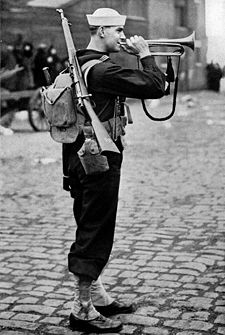Bugle: Difference between revisions
Reverted edit by 67.54.192.38 identified as vandalism using |STiki |
|||
| Line 41: | Line 41: | ||
*[[Soprano bugle]] (high pitch) |
*[[Soprano bugle]] (high pitch) |
||
*[[ |
*[[Mellophone|Alto bugle]] (medium to high pitch) |
||
*[[ |
*[[Baritone horn#Marching baritone|Baritone bugle]] (medium to low pitch) |
||
*[[ |
*[[Contrabass bugle]] (low pitch) |
||
*[[Contrabass bugle]] (bass pitch) |
|||
{{listen |
{{listen |
||
Revision as of 17:58, 10 October 2010

The bugle is one of the simplest brass instruments, having no valves or other pitch-altering devices. All pitch control is done by varying the player's embouchure, since the bugle has no other mechanism for controlling pitch. Consequently, the bugle is limited to notes within the harmonic series. See bugle call for scores to standard bugle calls, which all consist of only five notes.
History

The bugle developed from early musical or communication instruments made of animal horns,[1] with the word "bugle" itself coming from "buculus", Latin for bullock (castrated bull).[2] The earliest bugles were shaped in a coil – typically a double coil, but also a single or triple coil – similar to the modern French horn, and were used to communicate during hunts and as announcing instruments for coaches (somewhat akin to today's automobile horn). Predecessors and relatives of the developing bugle included the post horn, the Pless horn (sometimes called the "Prince Pless horn"), and the bugle horn.
The first verifiable formal use of a brass horn as a military signal device was the Halbmondblaser – literally, "half moon blower" – used in Hanover in 1758. It was U-shaped (hence its name) and comfortably carried by a shoulder strap attached at the mouthpiece and bell. It first spread to England in 1764 where it was gradually accepted widely in foot regiments. Cavalry did not normally use a proper bugle, but rather an early trumpet that might be mistaken for a bugle today, as it lacked keys or valves, but had a more gradual taper and a smaller bell, producing a sound more easily audible at close range but with less carrying power over distance.
Uses


The bugle is used mainly in the military where the bugle call is used to indicate the daily routines of camp. Historically the bugle was used in the cavalry to relay instructions from officers to soldiers during battle. Biblically, bugles are found in the time of Moses, when God commanded Moses to 'make two bugles of hammered silver' in Numbers 10:1-3. They were used to assemble the leaders and to give marching orders to the camps.
The bugle is also used to play Taps in military rites at funerals.
In the drum and bugle corps the bugle has evolved away from its military origins, growing valves. In American drum and bugle corps, G is considered the traditional key for bugles to be pitched in. However, current rules in both Drum Corps International and Drum Corps Associates define a bugle as a brass instrument in any key, with 0 to 4 valves, and bell front. Typically, drum corps brass is in G or B flat, with mellophones in B flat brass lines being in the key of F because of the ease of tuning for that particular horn.
Civilian drum corps were founded using equipment sold off by the military in the early 1900s, and the last official change made to the military bugle (before its role as a signaling device was rendered obsolete by the radio) was to standardize them in the key of G. Bugles in other parts of the world typically were pitched in B flat or E flat.
A challenge for those attempting to define bugles with such a general classification is to explain how bugles are different from any other kind of brass band instrument. It seems that the standardized American G military bugle has been replaced with B-flat and these new instruments are indistinguishable from common band instrumentation. The last of the distinguishing instrument features of drum and bugle corps from years prior to 2000 only exists in a few die-hard groups.
The bugle is also used in Boy Scout troops. They use many of the same calls as the military does, but not as many.
Variations
The cornet is sometimes erroneously considered to be the "valved version" of the bugle, although it was derived from the French cornet de poste (post horn).
19th century variants based on the standard bugle included keyed bugles and valved bugles. Keyed bugles were invented in England in the early 19th century, with a patent for one design, the Royal Kent bugle, taken out by Joseph Halliday in 1811. This bugle was highly popular and widely in use until c. 1850 – for example, in works by Richard Willis, later bandmaster of the United States Military Academy Band at West Point. This variant of the bugle fell out of use with the invention of the valved cornet.
Modern instruments classified as bugles are often valved.
Pitches of bugles
- Soprano bugle (high pitch)
- Alto bugle (medium to high pitch)
- Baritone bugle (medium to low pitch)
- Contrabass bugle (low pitch)
References
Notes
- ^ "History of the Bugle Horn". www.army.mod.uk. Retrieved 2008-05-03. [dead link]
- ^ "bugle - Definitions from Dictionary.com". dictionary.reference.com. Retrieved 2008-05-03.
Bibliography
- Ralph T. Dudgeon, The Keyed Bugle, Scarecrow Press, 2004, ISBN 0810851237
- Janet Chiefari, Introducing the Drum and Bugle Corps, Olympic Marketing Corp, 1982, ISBN 039608088X

